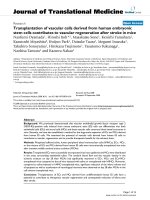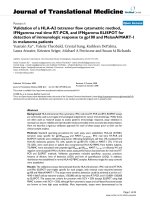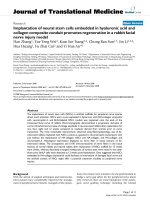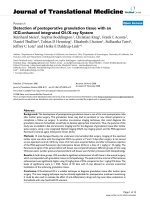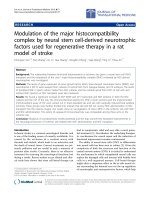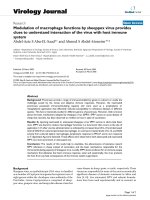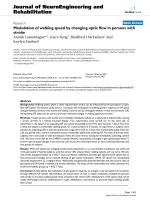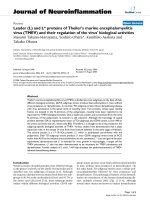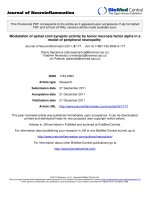Báo cáo hóa học: " Modulation of viral replication in macrophages persistently infected with the DA strain of Theiler''''s murine encephalomyelitis virus" docx
Bạn đang xem bản rút gọn của tài liệu. Xem và tải ngay bản đầy đủ của tài liệu tại đây (1.23 MB, 10 trang )
BioMed Central
Page 1 of 10
(page number not for citation purposes)
Virology Journal
Open Access
Research
Modulation of viral replication in macrophages persistently infected
with the DA strain of Theiler's murine encephalomyelitis virus
Stephane Steurbaut, Ellen Merckx, Bart Rombaut and Raf Vrijsen*
Address: Department of Pharmaceutical Biotechnology and Molecular Biology, Vrije Universiteit Brussel, Brussels, Belgium
Email: Stephane Steurbaut - ; Ellen Merckx - ; Bart Rombaut - ;
Raf Vrijsen* -
* Corresponding author
Abstract
Background: Demyelinating strains of Theiler's murine encephalomyelitis virus (TMEV) such as
the DA strain are the causative agents of a persistent infection that induce a multiple sclerosis-like
disease in the central nervous system of susceptible mice. Viral persistence, mainly associated with
macrophages, is considered to be an important disease determinant that leads to chronic
inflammation, demyelination and autoimmunity. In a previous study, we described the establishment
of a persistent DA infection in RAW macrophages, which were therefore named DRAW.
Results: In the present study we explored the potential of diverse compounds to modulate viral
persistence in these DRAW cells. Hemin was found to increase viral yields and to induce cell lysis.
Enviroxime and neutralizing anti-TMEV monoclonal antibody were shown to decrease viral yields,
whereas interferon-α and interferon-γ completely cleared the persistent infection. We also
compared the cytokine pattern secreted by uninfected RAW, DRAW and interferon-cured DRAW
macrophages using a cytokine protein array. The chemokine RANTES was markedly upregulated
in DRAW cells and restored to a normal expression level after abrogation of the persistent
infection with interferon-α or interferon-γ. On the other hand, the chemokine MCP-1 was
upregulated in the interferon-cured DRAW cells.
Conclusion: We have identified several compounds that modulate viral replication in an in vitro
model system for TMEV persistence. These compounds now await further testing in an in vivo
setting to address fundamental questions regarding persistent viral infection and
immunopathogenesis.
Background
The DA strain of Theiler's murine encephalomyelitis virus
(TMEV), a picornavirus belonging to the Cardiovirus
genus, is the causative agent of a biphasic disease in the
central nervous system (CNS) of susceptible mice. In a
first phase, the virus infects neurons and causes an acute
but mild encephalomyelitis that lasts for one to two
weeks. This is followed by a second phase, during which
the virus infects glial cells of the spinal cord's white matter
and that is characterized by chronic inflammation and
demyelination resembling the human disease multiple
sclerosis (MS) [1-3]. The virus persists lifelong in infected
mice, with macrophages representing the main viral reser-
voir [4,5]. Although various immune responses are acti-
vated to resist the viral infection, these defense
mechanisms are also suspected to inflict myelin damage,
Published: 4 August 2008
Virology Journal 2008, 5:89 doi:10.1186/1743-422X-5-89
Received: 29 April 2008
Accepted: 4 August 2008
This article is available from: />© 2008 Steurbaut et al; licensee BioMed Central Ltd.
This is an Open Access article distributed under the terms of the Creative Commons Attribution License ( />),
which permits unrestricted use, distribution, and reproduction in any medium, provided the original work is properly cited.
Virology Journal 2008, 5:89 />Page 2 of 10
(page number not for citation purposes)
e.g. anti-TMEV antibodies could cross-react with myelin
components such as galactocerebroside, resulting in virus-
induced autoimmune myelin destruction [6,7]. Infected
mice also mount a virus-specific CD4
+
Th1 lymphocyte
response that contributes to demyelination via bystander
damage induced by a delayed-type hypersensitivity
response [8]. Later, myelin epitopes, released as a conse-
quence of tissue destruction, lead to the activation of mye-
lin-specific Th1 cells that trigger autoimmunity [9]. Apart
from CD4
+
Th1 lymphocytes, CD8
+
T cells have also been
implicated in autoimmunity. Borrow et al [10] demon-
strated that CD8
+
T cells are important for viral clearance,
but these cells may also be critical effectors that aggravate
the demyelination [11-13]. In addition, TMEV infection
triggers the production of multiple cytokines and chem-
okines that likely initiate, enhance and/or perpetuate the
inflammatory responses leading to demyelination [14-
17]. Because demyelination is associated with ongoing
CNS infection, viral persistence is assumed to be necessary
for this pathology to develop. In addition, some mouse
strains develop encephalomyelitis after DA infection, but
are resistant to demyelination due to elimination of the
virus [18]. However, once autoimmunity is established in
susceptible mice, it remains unknown whether it can be
self-perpetuating when the virus would be cleared, a ques-
tion so far unaddressed due to the lack of Cardiovirus
inhibitors [19].
Previously, we have shown that Theiler's DA strain readily
establishes a long-term persistent infection in RAW264.7
macrophages (RAW). This persistently infected continu-
ous cell line has been termed DRAW. The infection was
productive and showed only restricted cytopathic effects
[20]. The purpose of the present study was to evaluate dif-
ferent treatments for their potential to modulate viral per-
sistence in DRAW cells, whereby both the downregulation
as well as the upregulation of the infection were consid-
ered. In addition, we examined the macrophages' cytokine
and chemokine expression pattern, before and after recov-
ery from persistent infection.
Results
Screening of compounds for a modulating effect on viral
persistence in DRAW cells
In a previous study, we reported DRAW macrophage cell
cultures to be persistently infected with the DA strain [20].
Here, we explored the possibility to modulate viral per-
sistence in DRAW cells using various compounds. These
compounds were selected in function of an anticipated or
established effect on picornavirus replication (Table 1).
DRAW cells, cultivated for approximately 3 months (20
passages) and seeded at 2.5 × 10
4
cells/well in 96-well
plates, were subjected to different concentrations (mostly
5-fold dilutions) of the various compounds. To make a
distinction between compound-induced cytotoxic effects
and virus-induced cytopathic effects, untreated DRAW
and compound-treated RAW as well as untreated RAW
cells were used as controls in the microscopic evaluation
of cytotoxicity. After 48 and 96 h, DRAW culture superna-
tants and cells were collected, and following three freeze-
thaw cycles, submitted to plaque assay. Only samples
without microscopic evidence of compound-induced
cytotoxicity were titrated. On the basis of the plaque assay
results, the compounds were categorized into three
Table 1: Listing of the compounds screened for a modulating effect on viral persistence in DRAW cells.
Compound Established effect, virus (strain) Reference Effect on TMEV yield from DRAW C
max
d
2-AP ↑
a
, TMEV (GDVII) [21] -
c
200 μg/ml
L-NAME ↑, CVB (CVB3) [22] - 250 μg/ml
L-NMMA ↑, CVB (CVB3) [23] - 250 μg/ml
2-FMC ↓
b
, HRV (HRV2) [24] - 0.1 μg/ml
hydantoin ↓, PV (Mahoney) [25] - 20 μg/ml
levamisole ↓, EMCV [26] - 200 μg/ml
pirodavir ↓, HRV (HRV9) [27] - 10 μg/ml
Compound Established effect, virus (strain) Reference Log
10
maximal increase or decrease
of TMEV yield from DRAW
e
EC
50
e
ED
f
hemin ↑, PV (Mahoney) [28] ↑; 0.99 ± 0.23 13 μg/ml 65 μg/ml
anti-TMEV mAb ↓, TMEV (DA, GDVII) [29] ↓; 1.12 ± 0.04 1:250 dilution 1:10 dilution
enviroxime ↓, HRV (HRV31) [30] ↓; 0.99 ± 0.13 0.1 μg/ml 0.316 μg/ml
IFN-α↓, TMEV (DA) [21] ↓; 4.89 ± 0.23 10 ng/ml 250 ng/ml
IFN-γ↓, TMEV (DA) [21] ↓; 5.89 ± 0.49 0.2 ng/ml 25 ng/ml
a
↑: increase of infectivity;
b
↓: decrease of infectivity;
c
-: no influence on infectivity;
d
C
max
: highest, non-cytotoxic concentration;
e
EC
50
: effective
concentration
50
= concentration of the compound inducing a twofold increase or decrease of infectious virus yield from DRAW cells, as
determined by titration in L929 cells;
f
ED: effective dose = concentration that maximally affected infectious virus yield from DRAW cells; CVB:
coxsackievirus B; EMCV: encephalomyocarditis virus; HRV: human rhinovirus; PV: poliovirus; TMEV: Theiler's murine encephalomyelitis virus. Data
are the mean result of duplicate samples from two independent experiments ± standard deviation
Virology Journal 2008, 5:89 />Page 3 of 10
(page number not for citation purposes)
classes: (1) 2-aminopurine nitrate (2-AP), 2-furylmercury
chloride (2-FMC), 5-(3,4-dichlorophenyl) methylhydan-
toin (hydantoin), levamisole, N
G
-nitro-L-arginine methyl
ester (L-NAME), N
G
-monomethyl-L-arginine (L-NMMA)
and pirodavir had no influence on virus yields compared
to those from untreated DRAW cells, (2) hemin led to an
increase of virus titers, and (3) neutralizing anti-TMEV
VP1 monoclonal antibody (mAb), enviroxime (ENV),
recombinant murine interferon (IFN)-α and recombinant
murine IFN-γ led to a decrease of infectivity (Table 1). Of
the compounds that affected virus titers in DRAW cells, we
determined the concentration that increased or decreased
virus yield by fifty percent and we named this the effective
concentration
50
(EC
50
) (Table 1). We also established the
effective dose (ED) of these compounds, i.e., the concen-
tration that maximally affected virus yield from DRAW
cells (Table 1).
Subsequently, a more detailed study with the compounds
that induced a modulating effect on virus replication in
DRAW cells was performed. A similar modus operandi
was followed for each of these compounds. DRAW cells,
cultivated in 96-well plates at 2.5 × 10
4
cells/well, were
treated with the ED of each compound. Culture superna-
tants and cells were harvested at the start of the experi-
ments and each following 24 h during 4 days, where after
the infectivity was determined by plaque assay. In parallel,
and in addition to the microscopic evaluation, each com-
pound's ED was further tested in detail for cytotoxicity
using the CellTiter-Blue cell viability assay that measures
cellular metabolic activity. Compound-treated RAW as
well as untreated DRAW and untreated RAW macrophages
were again used as reference. Cytotoxicity was also
assessed each 24 h during 4 days. As the EDs revealed to
be non-toxic (results not shown), the results of the viabil-
ity assay are only discussed where relevant. In the follow-
ing paragraphs, a more detailed analysis of the results
obtained with the different compounds is presented.
Hemin upregulates virus replication and induces lysis of
DRAW cells
Benton et al [28] have shown that hemin enhances polio-
virus replication in persistently infected K562-Mu erythro-
leukemia cells supposedly resulting from an increase in
host shut-off due to protease-induced cleavage of the
translation initiation factors eIF-4G and eIF-2α. In addi-
tion, hemin has been implicated in downregulation of the
IFN signaling pathway [31-33]. These observations
prompted us to investigate the effect of hemin on DRAW
cells. Treatment of DRAW macrophages with 65 μg/ml
hemin resulted in an average fivefold increase of virus tit-
ers that was maintained until the end of the experiment
(Figure 1A). Moreover, hemin treatment led to a gradual
decrease of the DRAW's viability over time (Figure 1B),
resulting in the lysis of nearly all cells after 4 days (Figure
1C). In contrast, hemin-treated RAW (Figure 1B and 1D)
and untreated DRAW cells (results not shown) remained
fit, proving that the effect of hemin on DRAW cells was
not due to compound-induced cytotoxicity, but probably
resulted from the upregulation of viral replication and/or
spread of the infection with a concomitant increase of
virus-induced cytopathic effects.
Enviroxime and anti-TMEV mAb decrease virus replication
in DRAW cells
Enviroxime has been shown to exert an antipicornaviral
effect on poliovirus and rhinoviruses through inhibition
of viral RNA synthesis [34]. Neutralizing mAbs bind to
virions thereby interfering with processes such as attach-
ment, entry or uncoating, which results in a decrease of
the infectivity [35]. We examined these compounds for
their potential to reduce virus titers in DRAW macro-
phages by treating the cells either with enviroxime (0.316
μg/ml; the highest non-cytotoxic dose) or with a neutral-
izing anti-TMEV mAb recognizing VP1 (1:10 dilution), as
well as with the combination of both. Compared to
untreated DRAW cells, treatment with enviroxime or with
anti-TMEV mAb, both led to an average decrease of the
infectivity with nearly 1 log
10
during the 4 days period that
the experiment was carried out (Figure 2A). The combina-
tion of enviroxime with anti-TMEV mAb resulted in a
decrease of the virus yield by about 2 log
10
. Although the
addition of enviroxime and anti-TMEV mAb alone, or
their combination decreased viral replication in DRAW
cells, none of these treatments was able to cure the macro-
phage cell cultures from their persistent infection.
IFN-
α
and IFN-
γ
clear DRAW cells of persistent viral
infection
IFNs are key mediators of the innate antiviral immune
response that are produced upon viral infection. They
exert their antiviral effects through the induction of pro-
teins such as the 2',5'-oligoadenylate synthetase, the dou-
ble-stranded RNA-dependent protein kinase and the Mx
proteins that mediate antiviral activity (for a review, see
[36]).
Previously, we have reported that IFN-α and IFN-γ con-
tribute to the antiviral response of RAW macrophages
against TMEV, whereas this could not be demonstrated for
IFN-β [21].
Here, we investigated the antiviral effect of IFN-α and IFN-
γ on the persistently infected macrophage cell cultures.
DRAW cells were treated with 250 ng/ml IFN-α or 25 ng/
ml IFN-γ. A spectacular decrease of the infectivity was
observed in IFN-treated DRAW cells, resulting in the com-
plete elimination of the virus after 72 h with IFN-γ and
after 96 h with IFN-α, whereas viral yields remained high
(4.76 log
10
) in untreated DRAW cells after 96 h (Figure
Virology Journal 2008, 5:89 />Page 4 of 10
(page number not for citation purposes)
2B). To ascertain that the IFN-treated DRAW cells were
indeed virus-free, the cells were further cultivated for 30
days and regularly assayed for infectious virus. Because we
never found any plaque, the persistent infection was
indeed cleared in these cells, which we termed CDRAW.
Viral infection upregulates RANTES in DRAW cells
In comparison with RAW cells, which displayed a round
morphology (Figure 3A), we observed that DRAW cells
showed a morphologic change in about 5 to 20% of the
total cell population, resulting in an elongated phenotype
(Figure 3B), which probably reflects an activation or dif-
ferentiation process. In contrast, CDRAW cells that were
cured from the persistent infection as a result of IFN-treat-
ment, again acquired a round morphology (Figure 3C).
No marked growth rate differences were observed
between the different cell lines (results not shown).
To investigate whether the similar morphologic appear-
ance between RAW and CDRAW cells would also be
reflected by their cytokine expression pattern and whether
this would be different from that of DRAW cells, we com-
pared the cytokine profile of these cell lines. Culture
supernatants of macrophages, seeded at 6 × 10
5
cells/well
in 6-well plates, were collected after 48 h and analyzed for
expression of cytokines and chemokines using a protein
array. Among other cytokines, RAW macrophages consti-
tutively secreted eotaxin-2, lipopolysaccharide-induced
Effect of hemin on DRAW and RAW cellsFigure 1
Effect of hemin on DRAW and RAW cells. Cells, seeded at a density of 2.5 × 10
4
cells/well in 96-well plates, were treated
with 65 μg/ml hemin or untreated. (A) Virus yield from DRAW cells was measured in function of time by plaque assay in L929
cells. Data are the mean result of duplicate samples from two independent experiments ± standard deviation; * P < 0.05
(unpaired Student's t test between untreated and compound-treated samples). (B) Cell viability of hemin-treated cells was
assayed using Promega's CellTiter-Blue kit on triplicate samples and expressed as a percentage of the values from untreated
control cells ± standard deviation; * P < 0.05 (unpaired Student's t test between hemin-treated RAW and DRAW cells. Phase-
contrast images of (C) hemin-induced lysis of DRAW cells and (D) normal appearing hemin-treated RAW cells. Magnification:
400×.
Virology Journal 2008, 5:89 />Page 5 of 10
(page number not for citation purposes)
CXC chemokine (LIX), lymphotactin, monocyte chem-
oattractant protein-1 (MCP-1), macrophage inflamma-
tory protein (MIP)-1α, MIP-1β, MIP-2 and P-selectin
(Figure 3D). In addition to the cytokines and chemokines
expressed by RAW macrophages, DRAW cells distinctly
produced more of the chemokine RANTES (regulated
upon activation, normal T-cell expressed and secreted)
(Figure 3E). This difference in RANTES production
between RAW and DRAW cells was also observed in cul-
ture supernatants collected at 96 h (results not shown).
CDRAW cells, originally treated with IFN-α (Figure 3F),
displayed a cytokine and chemokine expression pattern
qualitatively and quantitatively comparable to that of
RAW macrophages, including RANTES but with the excep-
tion of MCP-1 that was upregulated. The same results
were obtained with CDRAW cells, originally treated with
IFN-γ (results not shown).
Discussion
Viral infections can result in the establishment of a persist-
ent infection and this is quite often linked to a severe
pathology, e.g., human immunodeficiency virus-related
encephalopathy or hepatitis virus-induced liver injury
[37,38].
Viral persistence has also been recognized to be a key
determinant for the induction of TMEV-induced demyeli-
nation in mice that is studied as an experimental animal
Antiviral effect of compounds in DRAW cells in function of timeFigure 2
Antiviral effect of compounds in DRAW cells in function of time. (A) mAb (1:10 dilution), ENV (0.316 μg/ml) and
mAb + ENV; (B) IFN-α (250 ng/ml) and IFN-γ (25 ng/ml). Controls consist of untreated cells. Cells were cultivated in 96-well
plates at a density of 2.5 × 10
4
cells/well and virus yield was measured by plaque assay. Data are the mean result of duplicate
samples from two independent experiments ± standard deviation; * P < 0.05 (unpaired Student's t test between untreated and
compound-treated samples).
Virology Journal 2008, 5:89 />Page 6 of 10
(page number not for citation purposes)
model for human MS [3,18]. However, knowledge about
the mechanism by which TMEV persists is scanty as it is
the result of a complex interaction between the virus and
its host that is only partially understood [39]. In addition,
the inability to abrogate a persistent TMEV infection in
susceptible mice is a hindrance uncovering the exact role
of viral persistence in the pathogenesis of demyelination
and autoimmunity [19]. We previously described DRAW
macrophages as an in vitro model to study TMEV persist-
ence [20]. In this study, we assessed modulating the viral
persistence in these macrophage cell cultures using several
compounds that were selected for their established effect
on picornavirus replication. Two different strategies,
namely the upregulation as well as the downregulation of
the virus infection were hereby considered.
In another study, we reported that 2-AP, an inhibitor of
the double-stranded RNA-dependent protein kinase,
enhances the replication of Theiler's GDVII strain but not
that of the DA strain in RAW macrophages [21]. In line
with these results, 2-AP didn't affect virus yields from
DRAW cells. Neither did 2-FMC, an inhibitor of rhinovi-
rus RNA synthesis [24]; hydantoin, an inhibitor of polio-
virus post-synthetic protein cleavages and assembly [25];
levamisole, a compound known to potentiate the antivi-
ral effect of interferon against encephalomyocarditis virus
Phase-contrast images of (A) RAW; (B) DRAW and (C) CDRAW cellsFigure 3
Phase-contrast images of (A) RAW; (B) DRAW and (C) CDRAW cells. Magnification: 400×. Protein array analysis of secreted
cytokines by (D) RAW; (E) DRAW and (F) CDRAW cells. Cells were seeded at a density of 6 × 10
5
cells/well in 6-well plates.
Culture supernatants were collected after 48 h and analyzed with RayBiotech's mouse cytokine antibody array III (G). Spots
with differentially regulated cytokines are encircled.
Virology Journal 2008, 5:89 />Page 7 of 10
(page number not for citation purposes)
[26]; L-NAME and L-NMMA, two inhibitors of the cellular
inducible NO synthase and resulting in increased cox-
sackie B virus titers [22,23], and pirodavir, a capsid-bind-
ing compound that inhibits rhinovirus uncoating [27].
Hemin is a metalloporphyrin that has been documented
to increase poliovirus titers in persistently infected K562-
Mu erythroleukemia cells resulting in a cytolytic infection
[28]. Likewise, hemin-treated DRAW cells underwent lysis
that was not observed in hemin-treated RAW macro-
phages. Hemin treatment of the former also led to an aver-
age fivefold increase of virus titers compared to untreated
DRAW cells, which might be due to upregulation and/or
spread of the infection as a result of the hemin-induced
inhibition of interferon-mediated antiviral protection
[31]. The latter effect may be related to the upregulation
of ferritin, an iron-binding protein that can inhibit the
transcription of IFN-α/β by suppression of the transcrip-
tional activator nuclear factor-κB (NF-κB) [32,33]. Inter-
estingly, Zoll et al [40] found that the L protein of
mengovirus, like TMEV a member of the Cardiovirus
genus, also suppresses the production of IFN-α/β through
ferritin-mediated inhibition of NF-κB activation.
It has been speculated that the restricted replication of
TMEV in macrophages might shield the virus from effec-
tive immune recognition and contributes to the establish-
ment of the persistent infection [41-43]. Although hemin
was found to increase viral replication, it also induced cell
death, thereby potentially compromising its in vivo use
because it could spread the infection beyond control and
induce unwanted cell death.
The converse approach, consisting in the downregulation
of the viral replication to eventually cure the persistently
infected DRAW cells, may therefore be less hazardous. In
that context, enviroxime, an inhibitor of polio- and rhino-
virus RNA synthesis that presumably targets a replication
complex component that interacts with the viral protein
3A(B) [34], and neutralizing mAb raised against the cap-
sid protein VP1 of TMEV, were shown to exert an antiviral
effect in DRAW cells. Added individually, both com-
pounds reduced the virus titers approximately 10-fold.
When combined together, a 100-fold decrease in virus
yield was noticed, demonstrating additive antiviral activ-
ity that likely results from their different mode of action.
Although the decrease of infectivity was maximally 2
log
10
, it must be said that we only added the compounds
once (at the start of the experiment). It may be worthwhile
to investigate the effect of multiple administrations,
which might increase the antiviral efficacy.
We also explored the possibility of using IFNs to lower the
infectious titers in DRAW cells. IFNs are produced by
virus-infected cells and play a crucial role in the host's
defense against viruses by conferring an antiviral state in
neighboring, uninfected cells [36]. In this study, IFN-γ
(type II IFN) and IFN-α (a type I IFN) were shown to
inhibit viral replication to the point that no infectious
virus was found anymore after 72 to 96 h, respectively.
Others have shown the importance of IFNs in neuronal
viral clearance and prevention of TMEV persistence using
IFN- and IFN receptor-deficient mice [44,45]. However,
this is the first report, as far as we know, demonstrating
IFN-induced clearance of a persistent TMEV infection.
These results indicate that there might be a therapeutic
potential to cure mice persistently infected with TMEV.
Apart from their antiviral effect, IFNs are also potent
immunomodulators and Njenga et al [46] have shown
that IFN-α/β treatment can result in the promotion of
remyelination as well as in the aggravation of demyelina-
tion depending on the duration of the treatment.
Chemokines are chemotactic cytokines that are responsi-
ble for the migration and accumulation of leukocytes in
specific tissue sites. Accumulating evidence indicates a
role for chemokines in the pathogenesis of various CNS
inflammatory diseases, including MS and virus-induced
demyelination (for a review, see [47]). By comparison of
the cytokine expression pattern between DRAW and unin-
fected RAW macrophages using protein arrays, we found
one major difference, i.e., the upregulation of the chem-
okine RANTES in DRAW cells. Interestingly, other investi-
gators have reported increased RANTES mRNA expression
in the context of TMEV infections [48,49]. In CDRAW
cells, on the other hand, where the persistent infection
was cleared with IFN, RANTES showed the same low
expression level as in uninfected RAW cells. This indicates
that its upregulation in DRAW cells is related to the pres-
ence and/or replication of the virus. Interestingly,
RANTES has also been detected in brain lesions of MS
patients [50] and the RANTES gene might be linked with
an increased genetic susceptibility to this disease [51]. In
addition to its role as a chemoattractant, RANTES seems
also important in viral clearance by mediating resistance
against virus-induced death of macrophages [52] and its
transcriptional upregulation is drastically antagonized by
the leader protein of TMEV [53]. Therefore, the activation
of RANTES might be a double-edged sword, contributing
to antiviral defense at one hand and leading to inflamma-
tory cell recruitment with immunopathologic injury on
the other hand.
We also found an upregulation of the chemokine MCP-1
in CDRAW cells compared to RAW and DRAW macro-
phage cell cultures. Recently, Karpus et al [54] have shown
the importance of this chemokine by inhibiting Theiler's
virus induced-demyelination with anti-MCP-1 antibod-
ies. Consequently, as with RANTES, MCP-1 seems to play
a crucial role in the pathogenesis of demyelinating dis-
Virology Journal 2008, 5:89 />Page 8 of 10
(page number not for citation purposes)
ease, but further research is necessary to unravel their
exact contribution. Apart from the above mentioned
cytokines, other cytokines might play a role in TMEV
infection of macrophages as evidenced by recent work
[55,56].
Conclusion
We have identified several compounds that modulate
viral replication in an in vitro model system for TMEV per-
sistence by increasing or decreasing virus titers. Because
there might be a rational basis for the upregulation as well
as the downregulation of viral replication, these strategies
now await further testing in an in vivo setting to address
fundamental questions regarding persistent viral infection
and immunopathogenesis. In addition, our results dem-
onstrate the potential of DRAW cells to be used as a
screening platform for the selection of known as well as
future compounds for their effect on TMEV persistence.
Materials and methods
Cells
RAW264.7 cells, a mouse macrophage cell line derived
from an Abelson murine leukemia virus-induced tumor in
BALB/c mice, were kindly donated by T. Michiels (Chris-
tian de Duve Institute of Cellular Pathology, UCL, Bel-
gium). DRAW macrophages were originally obtained by
infection of RAW cells with 10 PFU/cell of Theiler's DA
strain and ever since are persistently infected with this
strain with the concomitant production of infectious virus
[20]. CDRAW macrophages were obtained by treating
DRAW cells with IFN-α or IFN-γ as a result of which the
persistent infection was cleared. RAW, DRAW and
CDRAW cells were grown in Dulbecco's modified Eagle
medium (DMEM) with 2.5% fetal bovine serum (FBS).
L929 cells, originally derived from normal subcutaneous
areolar and adipose tissue of a 100-day-old male C3H/An
mouse and purchased from ATCC, were used for plaque
assay. Cells were grown as monolayers in minimal essen-
tial medium supplemented with Earle's salts, nonessential
amino acids, 1 mM sodium pyruvate, and 5% horse
serum. All medium components were purchased from
Invitrogen (Merelbeke, Belgium).
Compounds
Compounds were dissolved as follows: stock solutions of
10 mg/ml of 2-FMC, enviroxime and pirodavir (kindly
provided by Dr. Andries, Johnson and Johnson Pharma-
ceutical R&D, Beerse, Belgium), as well as hydantoin
(Lilly Research Laboratories, Indianapolis, IN, USA) were
made in dimethyl sulfoxide and diluted in medium, i.e.,
DMEM with 2.5% FBS, before use. Stock solutions of 10
mg/ml 2-AP; 4 mg/ml levamisole; 10 mg/ml L-NAME and
1 mg/ml L-NMMA were directly made in medium; hemin:
a stock solution of 3.25 mg/ml was prepared by adding 1
ml of 1 M NaOH to 40 mg of hemin, followed by the
addition of 10.1 ml DMEM and 1.2 ml of 1 M HCl. 2-AP,
hemin, levamisole, L-NAME and L-NMMA were pur-
chased from Sigma (Bornem, Belgium). Stock solutions
were sterilized by filtration through 0.2 μm pore-size fil-
ters (Machery-Nagel, Düren, Germany). Stock solutions
of 100 μg/ml recombinant murine IFN-α (HyCult bio-
technology, Uden, The Netherlands) and 1 mg/ml recom-
binant murine IFN-γ (PeproTech, Rocky Hill, NJ, USA)
were made in medium. Neutralizing mAb, originally
obtained from Dr. Brahic (Institut Pasteur, Paris, France),
was diluted in medium.
Experiments were performed in 96-well plates (Greiner
Bio-One, Wemmel, Belgium) in a total volume of 200 μl
consisting of 100 μl medium with cells and 100 μl
medium containing the compound.
Plaque assay
Infective titers were determined in culture supernatants
and cells by a standard plaque assay on confluent L929
cells grown in 60 mm Petri dishes (Greiner Bio-One,
Wemmel, Belgium) as described previously [20]. Samples,
consisting of supernatants and cells, were analyzed after
three rounds of freezing and thawing.
Cell viability assay
Compound-induced cytotoxicity was evaluated in RAW
and DRAW cells using the CellTiter-Blue cell viability
assay (Promega, Leiden, The Netherlands) that measures
the metabolic activity of cells based upon the reduction of
the indicator dye resazurin into the highly fluorescent
resorufin. Cells were seeded at 2.5 × 10
4
cells/well in black
96-well plates. The viability was determined at the start of
the experiment and each following 24 h during 4 days
according to the manufacturer's instructions. Briefly, after
2 h of incubation of the cells with the indicator dye at
37°C, the fluorescence was measured at an excitation
wavelength of 530 ± 25 nm and an emission wavelength
of 590 ± 35 nm with a Bio-Tek FL600 microplate fluores-
cence reader. Triplicate samples were assayed, background
corrected and the results were expressed as a percentage of
the values from untreated control cells.
Cytokine protein arrays
Cytokine expression profiling was performed on culture
supernatants from 6 × 10
5
cells using the mouse cytokine
antibody array III from RayBiotech (Norcross, GA, USA)
that allows the simultaneous detection of 62 different
murine cytokines and chemokines (Figure 3G). Analysis
was done according to the instructions of the manufac-
turer. Briefly, cytokine array membranes were first treated
with blocking buffer, washed and then incubated with 1.5
ml of culture supernatants from either RAW, DRAW or
CDRAW macrophages for 1.5 h. After washing, 1 ml of
Virology Journal 2008, 5:89 />Page 9 of 10
(page number not for citation purposes)
biotin-conjugated anti-cytokine detection antibodies was
added. Following a further incubation of 1.5 h, the mem-
branes were washed again and finally incubated with 2 ml
of horseradish peroxidase-conjugated streptavidin for 2 h.
The results were visualized on Kodak's Biomax MR X-ray
film following enhanced chemiluminescence detection.
Phase-contrast microscopy
Phase-contrast microscopy was performed with a Zeiss
Axiovert100 microscope and photomicrographs were
taken with an AxioCam MRc5 digital camera.
Competing interests
The authors declare that they have no competing interests.
Authors' contributions
SS participated in the experimental design, implementa-
tion and interpretation of results and performed all the
experiments. SS is also the main contributing author of
this manuscript. EM participated in cytokine protein
arrays experiments and manuscript preparation. BR took
part in discussing the results and supervised the study. RV
helped with experimental design, data interpretation and
supervised the study.
All authors read and approved the final manuscript.
Acknowledgements
The authors are grateful to Monique De Pelsmacker, Solange Peeters,
Frank Van Der Kelen and Kris Vantyghem for their excellent technical
assistance and to Bert Thys for his critical advice. We also thank Dr. Albert
Geerts for allowing us to use the phase-contrast microscope. Dr. Yvan
Vander Heyden is thanked for his advice on the presentation of the data
and the statistical analysis. This work was supported by the Charcot Foun-
dation.
References
1. Dal Canto MC, Lipton HL: Multiple sclerosis. Animal
model:Theiler's virus infection in mice. Am J Pathol 1977,
88:497-500.
2. Lipton HL: Theiler's virus infection in mice: an unusual bipha-
sic disease process leading to demyelination. Infect Immun
1975, 11:1147-1155.
3. Oleszak EL, Chang JR, Friedman H, Katsetos CD, Platsoucas CD:
Theiler's virus infection: a model for multiple sclerosis. Clin
Microbiol Rev 2004, 17:174-207.
4. Lipton HL, Twaddle G, Jelachich ML: The predominant virus anti-
gen burden is present in macrophages in Theiler's murine
encephalomyelitis virus-induced demyelinating disease. J
Virol 1995, 69:2525-2533.
5. Rossi CP, Delcroix M, Huitinga I, McAllister A, van RN, Claassen E,
Brahic M: Role of macrophages during Theiler's virus infec-
tion. J Virol 1997, 71:3336-3340.
6. Fujinami RS, Zurbriggen A, Powell HC: Monoclonal antibody
defines determinant between Theiler's virus and lipid-like
structures. J Neuroimmunol 1988, 20:25-32.
7. Yamada M, Zurbriggen A, Fujinami RS: Monoclonal antibody to
Theiler's murine encephalomyelitis virus defines a determi-
nant on myelin and oligodendrocytes, and augments demy-
elination in experimental allergic encephalomyelitis. J Exp
Med 1990, 171:1893-1907.
8. Clatch RJ, Lipton HL, Miller SD: Characterization of Theiler's
murine encephalomyelitis virus (TMEV)-specific delayed-
type hypersensitivity responses in TMEV-induced demyeli-
nating disease: correlation with clinical signs. J Immunol 1986,
136:920-927.
9. Miller SD, Vanderlugt CL, Begolka WS, Pao W, Yauch RL, Neville KL,
Katz-Levy Y, Carrizosa A, Kim BS: Persistent infection with
Theiler's virus leads to CNS autoimmunity via epitope
spreading. Nat Med 1997, 3:1133-1136.
10. Borrow P, Tonks P, Welsh CJ, Nash AA: The role of CD8+T cells
in the acute and chronic phases of Theiler's murine enceph-
alomyelitis virus-induced disease in mice. J Gen Virol
1992, 73 (
Pt 7):1861-1865.
11. Tsunoda I, Kuang LQ, Fujinami RS: Induction of autoreactive
CD8+ cytotoxic T cells during Theiler's murine encephalo-
myelitis virus infection: implications for autoimmunity. J Virol
2002, 76:12834-12844.
12. Tsunoda I, Kuang LQ, Kobayashi-Warren M, Fujinami RS: Central
nervous system pathology caused by autoreactive CD8+ T-
cell clones following virus infection. J Virol 2005,
79:14640-14646.
13. Tsunoda I, Libbey JE, Kobayashi-Warren M, Fujinami RS: IFN-
gamma production and astrocyte recognition by autoreac-
tive T cells induced by Theiler's virus infection: role of viral
strains and capsid proteins. J Neuroimmunol 2006, 172:85-93.
14. Hoffman LM, Fife BT, Begolka WS, Miller SD, Karpus WJ: Central
nervous system chemokine expression during Theiler's
virus-induced demyelinating disease. J Neurovirol 1999,
5:635-642.
15. Olson JK, Girvin AM, Miller SD: Direct activation of innate and
antigen-presenting functions of microglia following infection
with Theiler's virus. J Virol 2001, 75:9780-9789.
16. Palma JP, Kwon D, Clipstone NA, Kim BS: Infection with Theiler's
murine encephalomyelitis virus directly induces proinflam-
matory cytokines in primary astrocytes via NF-kappaB acti-
vation: potential role for the initiation of demyelinating
disease. J Virol 2003, 77:6322-6331.
17. Palma JP, Kim BS: The scope and activation mechanisms of
chemokine gene expression in primary astrocytes following
infection with Theiler's virus. J Neuroimmunol 2004, 149:121-129.
18. Chamorro M, Aubert C, Brahic M: Demyelinating lesions due to
Theiler's virus are associated with ongoing central nervous
system infection. J Virol 1986, 57:992-997.
19. Lipton HL, Kumar AS, Trottier M: Theiler's virus persistence in
the central nervous system of mice is associated with contin-
uous viral replication and a difference in outcome of infec-
tion of infiltrating macrophages versus oligodendrocytes.
Virus Res 2005, 111:214-223.
20. Steurbaut S, Rombaut B, Vrijsen R: Persistent infection of
RAW264.7 macrophages with the DA strain of Theiler's
murine encephalomyelitis virus: An in vitro model to study
viral persistence. J Neurovirol 2006, 12:108-115.
21. Benton PA, Barrett DJ, Matts RL, Lloyd RE: The outcome of polio-
virus infections in K562 cells is cytolytic rather than persist-
ent after hemin-induced differentiation. J Virol 1996,
70:5525-5532.
22. Fiorucci G, Percario ZA, Coccia EM, Battistini A, Rossi GB, Romeo G,
Affabris E: Hemin inhibits the interferon-beta-induced antivi-
ral state in established cell lines. J Interferon Cytokine Res 1995,
15:395-402.
23. Lin JJ, niels-McQueen S, Patino MM, Gaffield L, Walden WE, Thach RE:
Derepression of ferritin messenger RNA translation by
hemin in vitro. Science 1990, 247:74-77.
24. Tsai PS, Chen CC, Tsai PS, Yang LC, Huang WY, Huang CJ: Heme
oxygenase 1, nuclear factor E2-related factor 2, and nuclear
factor kappaB are involved in hemin inhibition of type 2 cat-
ionic amino acid transporter expression and L-Arginine
transport in stimulated macrophages. Anesthesiology 2006,
105:1201-1210.
25. Heinz BA, Vance LM: The antiviral compound enviroxime tar-
gets the 3A coding region of rhinovirus and poliovirus. J Virol
1995, 69:4189-4197.
26. Vrijsen R, Mosser A, Boeye A: Postabsorption neutralization of
poliovirus. J Virol 1993, 67:3126-3133.
27. Goodbourn S, Didcock L, Randall RE: Interferons: cell signalling,
immune modulation, antiviral response and virus counter-
measures. J Gen Virol 2000, 81:2341-2364.
28. Steurbaut S, Rombaut B, Vrijsen R: Theiler's virus strain-depend-
ent induction of innate immune responses in RAW264.7
Publish with BioMed Central and every
scientist can read your work free of charge
"BioMed Central will be the most significant development for
disseminating the results of biomedical research in our lifetime."
Sir Paul Nurse, Cancer Research UK
Your research papers will be:
available free of charge to the entire biomedical community
peer reviewed and published immediately upon acceptance
cited in PubMed and archived on PubMed Central
yours — you keep the copyright
Submit your manuscript here:
/>BioMedcentral
Virology Journal 2008, 5:89 />Page 10 of 10
(page number not for citation purposes)
macrophages and its influence on viral clearance versus viral
persistence. J Neurovirol 2007, 13:47-55.
29. Huang L, Koziel MJ: Immunology of hepatitis C virus infection.
Curr Opin Gastroenterol 2000, 16:558-564.
30. Persidsky Y, Gendelman HE: Mononuclear phagocyte immunity
and the neuropathogenesis of HIV-1 infection. J Leukoc Biol
2003, 74:691-701.
31. Brahic M, Bureau JF, Michiels T: The genetics of the persistent
infection and demyelinating disease caused by Theiler's
virus. Annu Rev Microbiol 2005, 59:279-298.
32. Verheyden B, Andries K, Rombaut B: Mode of action of 2-furylm-
ercury chloride, an anti-rhinovirus compound. Antiviral Res
2004, 61:189-194.
33. Vance LM, Moscufo N, Chow M, Heinz BA: Poliovirus 2C region
functions during encapsidation of viral RNA. J Virol 1997,
71:8759-8765.
34. Munoz A, Garcia RA, Perez-Aranda A: Potentiation by levami-
sole, methisoprinol, and adenine or adenosine of the inhibi-
tory activity of human interferon against
encephalomyocarditis virus. Antimicrob Agents Chemother 1986,
30:192-195.
35. Hiraoka Y, Kishimoto C, Takada H, Nakamura M, Kurokawa M,
Ochiai H, Shiraki K: Nitric oxide and murine coxsackievirus B3
myocarditis: aggravation of myocarditis by inhibition of
nitric oxide synthase. J Am Coll Cardiol 1996, 28:1610-1615.
36. Lowenstein CJ, Hill SL, Lafond-Walker A, Wu J, Allen G, Landavere
M, Rose NR, Herskowitz A: Nitric oxide inhibits viral replication
in murine myocarditis. J Clin Invest 1996, 97:1837-1843.
37. Andries K, Dewindt B, Snoeks J, Willebrords R, van EK, Stokbroekx
R, Janssen PA: In vitro activity of pirodavir (R 77975), a substi-
tuted phenoxy-pyridazinamine with broad-spectrum antipi-
cornaviral activity. Antimicrob Agents Chemother 1992, 36:100-107.
38. Zoll J, Melchers WJ, Galama JM, van Kuppeveld FJ: The mengovirus
leader protein suppresses alpha/beta interferon production
by inhibition of the iron/ferritin-mediated activation of NF-
kappa B. J Virol 2002, 76:
9664-9672.
39. Martinat C, Mena I, Brahic M: Theiler's virus infection of primary
cultures of bone marrow-derived monocytes/macrophages.
J Virol 2002, 76:12823-12833.
40. Obuchi M, Yamamoto J, Uddin N, Odagiri T, Iizuka H, Ohara Y:
Theiler's murine encephalomyelitis virus (TMEV) subgroup
strain-specific infection in neural and non-neural cell lines.
Microbiol Immunol 1999, 43:885-892.
41. Shaw-Jackson C, Michiels T: Infection of macrophages by
Theiler's murine encephalomyelitis virus is highly dependent
on their activation or differentiation state. J Virol 1997,
71:8864-8867.
42. Fiette L, Aubert C, Muller U, Huang S, Aguet M, Brahic M, Bureau JF:
Theiler's virus infection of 129Sv mice that lack the inter-
feron alpha/beta or interferon gamma receptors. J Exp Med
1995, 181:2069-2076.
43. Rodriguez M, Zoecklein LJ, Howe CL, Pavelko KD, Gamez JD,
Nakane S, Papke LM: Gamma interferon is critical for neuronal
viral clearance and protection in a susceptible mouse strain
following early intracranial Theiler's murine encephalomy-
elitis virus infection. J Virol 2003, 77:12252-12265.
44. Njenga MK, Coenen MJ, DeCuir N, Yeh HY, Rodriguez M: Short-
term treatment with interferon-alpha/beta promotes remy-
elination, whereas long-term treatment aggravates demyeli-
nation in a murine model of multiple sclerosis. J Neurosci Res
2000, 59:661-670.
45. Karpus WJ: Chemokines and central nervous system disor-
ders. J Neurovirol 2001, 7:493-500.
46. Kim BS, Palma JP, Kwon D, Fuller AC: Innate immune response
induced by Theiler's murine encephalomyelitis virus infec-
tion. Immunol Res 2005, 31:1-12.
47. Theil DJ, Tsunoda I, Libbey JE, Derfuss TJ, Fujinami RS: Alterations
in cytokine but not chemokine mRNA expression during
three distinct Theiler's virus infections. J Neuroimmunol 2000,
104:22-30.
48. Hvas J, McLean C, Justesen J, Kannourakis G, Steinman L, Oksenberg
JR, Bernard CC: Perivascular T cells express the pro-inflam-
matory chemokine RANTES mRNA in multiple sclerosis
lesions. Scand J Immunol 1997, 46:195-203.
49. Gade-Andavolu R, Comings DE, MacMurray J, Vuthoori RK, Tourtel-
lotte WW, Nagra RM, Cone LA:
RANTES: a genetic risk marker
for multiple sclerosis. Mult Scler 2004, 10:536-539.
50. Tyner JW, Uchida O, Kajiwara N, Kim EY, Patel AC, O'Sullivan MP,
Walter MJ, Schwendener RA, Cook DN, Danoff TM, Holtzman MJ:
CCL5-CCR5 interaction provides antiapoptotic signals for
macrophage survival during viral infection. Nat Med 2005,
11:1180-1187.
51. Paul S, Michiels T: Cardiovirus leader proteins are functionally
interchangeable and have evolved to adapt to virus replica-
tion fitness. J Gen Virol 2006, 87:1237-1246.
52. Karpus WJ, Kennedy KJ, Fife BT, Bennett JL, Dal Canto MC, Kunkel
SL, Lukacs NW: Anti-CCL2 treatment inhibits Theiler's
murine encephalomyelitis virus-induced demyelinating dis-
ease. J Neurovirol 2006, 12:251-261.
53. Hause L, Al-Salleeh FM, Petro TM: Expression of IL-27 p28 by
Theiler's virus-infected macrophages depends on TLR3 and
TLR7 activation of JNK-MAP-kinases. Antiviral Res 2007,
76:159-167.
54. Petro TM: ERK-MAP-kinases differentially regulate expres-
sion of IL-23 p19 compared with p40 and IFN-beta in
Theiler's virus-infected RAW264.7 cells. Immunol Lett 2005,
97:47-53.
55. Nitayaphan S, Toth MM, Roos RP: Neutralizing monoclonal anti-
bodies to Theiler's murine encephalomyelitis viruses. J Virol
1985, 53:651-657.
56. Delong DC, Reed SE: Inhibition of rhinovirus replication in in
organ culture by a potential antiviral drug. J Infect Dis 1980,
141:87-91.
